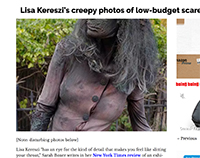October 2018 - boingboing
Lisa Kereszi’s creepy photos of low-budget scare attractions
Lisa Kereszi “has an eye for the kind of detail that makes you feel like slitting your throat,” Sarah Boxer writes in her New York Times review of an exhibition that included Kereszi’s photos of Governors Island, in New York Harbor. A courtesy phone the color of freshly dried blood; a drinking fountain that somehow manages to look sinister against the traffic-cone orange of the wall behind it; an abandoned motel room whose queasy-green carpet still bears the ghost image of a bed, a discolored rectangle uncomfortably reminiscent of a grave: looking at Kereszi’s images of the former military and Coast Guard base, we have to agree with Boxer’s observation that she “revels in…plain and awful surfaces.”
Kereszi, who is director of undergraduate studies in the Yale School of Art when she isn’t prowling modern ruins, captures the uncanniness of the banal, the creepy melancholy of the abject, the disquieting blur at the edge of camera frame. Boxer compares her work to Eugène Atget’s proto-surrealist photographs of dreamlike boulevards and sleepwalking mannequins in Belle-Époque Paris but to my mind it’s more accurately a cross between Diane Arbus’s mixture of the mundane and the insinuating — her ability to render the everyday freakish with the snap of a shutter — and the nameless creepiness of David Lynch. (I’m thinking of the saloon singer’s apartment in Blue Velvet.)
Nowhere is this quality more abundantly on display than in Haunted, a “Halloween series” of “temporary and semi-permanent scare attractions” Kereszi has “been working on, on and off, since 2004,” as she told me in an e-mail. Inspired, in part, by a 1961 Diane Arbus photo taken inside the Spook-a-Rama ride at Coney Island, Kereszi’s images of down-at-the-heel dark rides and ramshackle spookhouses are unsettling in a way never intended by their creators. “There is a dislocated sense of space in these transitory structures, and something about the failure of the fantasy to sustain its scare factor under daylight or flash,” she points out. “There’s also something about finding beauty and poetry in these otherwise horrible, grotesque” — and, be it said, kitschy and unintentionally campy — tableaux, not to mention “an uncomfortable amount of violence against women, and of sexualizing violence in general. Male mannequins are obviously also being tortured and dismembered in the setups, but it’s the women who are scantily clad, with nipples protruding, mouths open, dressed as vixens in S&M gear and fishnet stockings, tied up.”
In Haunted, Kereszi lifts the trapdoor of the pop unconscious, exposing the more deeply disturbing things we sublimate into horror films and haunted-house rides. Her inspirations for the series are revealing: Arbus’s Spook-a-Rama photo as well as “the one of the Psycho house facade, which shows the support beams holding the thing up,” along with Garry Winogrand’s images, in his book Public Relations, of photo ops and other staged P.R. events “photographed from behind the press corps or the politician, making the image that no one was supposed to see, the one that is maybe more accurate, and certainly more critical.” In Haunted, she says, “I am using specific kinds of places as material in which to create something poetic and meaningful that is about death and dying and fear and escapism.”
Kereszi’s own fears — and dreams of escape — are rooted in memories of “growing up in a world where drugs were part of the family dynamic — that and suicide, which is the ultimate escape. I grew up myself wanting to escape this difficult environment and milieu. Truth to tell, she confides, “I hate horror movies and roller coasters. I have enough real fear and anxiety that I don’t really need any more of it, even fake. It’s a mystery to me why I am drawn to these places. Or maybe it’s painfully obvious.”
— Mark Dery
Mark Dery is a cultural critic who writes about the media, society, visual culture, and American mythologies (and pathologies).
